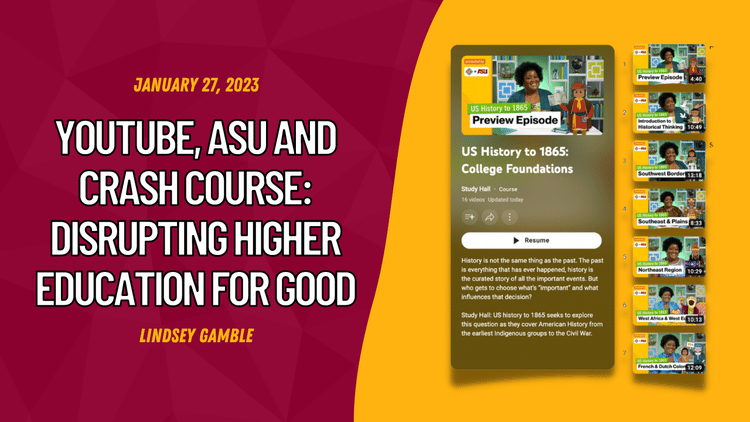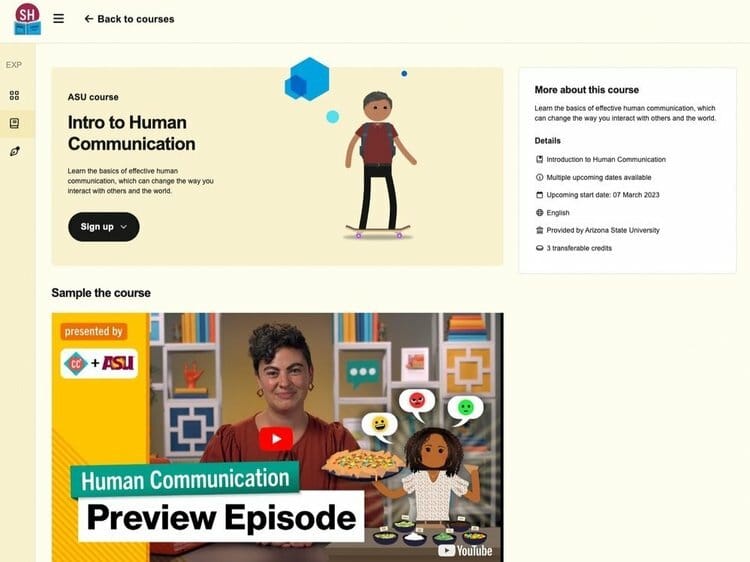
Welcome back! I’m planning to attend a few conferences this year. If you are attending any or have recommendations, please let me know!
Today’s Edition:
YouTube, ASU, and Crash Course unite for affordable and accessible higher education
TikTok “heats” videos to attract creators and brands
India introduces new guidelines for celebrities and influencers
YouTube, ASU, and Crash Course Unite for Affordable and Accessible Higher Education

YouTube is partnering with Arizona State University (ASU) and Hank and John Green’s Crash Course on Study Hall, a new initiative to create affordable and accessible college learning with transferable college credits.
How It Will Work
Starting this week, learners can sign up for “College Foundations” courses, which include common first-year courses such as English Composition, College Math, US History, and Human Communication. Courses are developed and taught by ASU faculty members, who also research and teach on its campuses.
Learners can get started immediately as there are no applications or minimum GPA requirements. They can also watch courses at no cost. But, there is a $25 fee for students who choose to take coursework and a $400 fee to receive college credit for each course, which is transferable at any institution that accepts transfer credit from ASU. Students can take courses as often as needed to achieve their desired grades. Study Hall is expected to expand to 12 available courses by January 2025.
An Innovative and Equitable Pathway to Higher Education
Study Hall delivers an innovative and equitable pathway to higher education. It allows students to take college-level courses and earn credits before even applying to college. By doing so, they also can get insight into what majors they may be interested in or whether college is right for them. The best thing is that they can do all these without significant investment. With course credits being significantly cheaper than the average course costs for both public and private four-year universities, students can benefit from higher education without the financial burden.
Beyond course credits and low costs, Study Hall is notable because it reflects a growing trend of people, especially younger generations learning through social media platforms like YouTube. As studies have shown, much of Gen Z prefers to learn from YouTube and videos rather than printed books. Courses coming through YouTube and in video formats allow students to learn in a familiar and preferred environment.
Disrupting Higher Education for Good
Study Hall is just one of the more recent examples of how creators and social media are disrupting higher education for good. Among the most notable moves in the interaction between social media and higher education, YouTube has played a prominent role in some form. In September, YouTube announced the launch of new educational product features to help creators offer interactive courses. A month after that, MrBeast, the world’s most subscribed YouTuber, and East Carolina University announced a new credential program to prepare students to work in the creator economy.
What’s Next
Study Hall's early success could spur the advancement of higher education by demonstrating that education can be conducted outside of traditional classrooms. Upgrading the college path can make it more affordable and accessible, benefiting more students. As more educational institutions recognize the value of social media in learning, other colleges and universities, particularly those that are forward-thinking, are likely to adopt similar programs.
TikTok “Heats” Videos to Attract Creators and Brands

TikTok has been “heating” videos, according to recent document leaks.
What “Heating” Is
A TikTok internal document, the MINT Heating Playbook, defines "heating" as "boosting videos into the ‘For You’ page (FYP) via operations intervention to achieve a certain number of video views." In simpler terms, it refers to employees hand-selecting videos from creators and brands to increase their distribution.
“Heating” videos has never been publicly disclosed by TikTok. But, it's a tactic that most social media platforms engage in to some extent, mostly when amplifying socially minded messages such as information around vaccinations and voting. In TikTok's case, "heating" is reportedly used to attract creators and brands by inflating their video view counts. Former employees also report that employees will sometimes "heat" videos of their own or friends and family, which is a violation of company policy.
The Issue With It
TikTok did recently confirm that it will “heat” videos as a way to introduce celebrities and emerging creators to its community as well as diversify the content experience. The act of “heating” isn’t necessarily the issue. It’s that the platform has always been positioned as a level playing field for creators due to its algorithm. But with revelations of some videos being pushed manually, especially in the interest of TikTok, that perception is called into question.
Whether it's organic or paid content, we assume that the videos we see on the FYP on TikTok are there because the algorithm determined they align with our interests and viewing behavior. When videos are “heated,” the platform instead promotes videos that serve its interests rather than the users. Plus, it essentially takes away the opportunity for a creator to get on the FYP organically.
The Potential Solution
When videos are served to users via paid media, they have a “sponsored” label. If we think about the concept of “heating,” it’s not too different than a video that is amplified via paid dollars. Because of this, TikTok should consider adding a label to videos that it “heats” to provide transparency for users who come across them and provide them with a clear understanding of the content they are viewing. This would align greatly with its recent push to increase transparency for its users.
India Introduces New Guidelines for Celebrities and Influencers

India's Department of Consumer Affairs has introduced Endorsement Kno-hows, a new set of guidelines for celebrities, influencers, and virtual influencers. They aim to ensure that individuals do not mislead their audiences when endorsing products or services and that they comply with the Consumer Protection Act, 2019 and any associated rules and guidelines.
Here are the key highlights:
Disclosures are required whenever there is a material connection between an advertiser and celebrity or influencer, including monetary or other compensation, free products with or without any conditions attached, contest and sweepstakes entries, trips or hotel stays, media barters, coverage, and awards or any family, personal or employment relationship.
Disclosures should be "extremely hard to miss" and should be placed in the content itself (e.g., superimposed over the image or video).
Endorsements must be made in simple, clear language and terms (e.g., advertisement, sponsored, paid promotion) and should be separate from platform disclosure tools.
Under the CPA, endorsers and advertisers can be penalized up to $12,300 (1 million Indian rupees) or up to $61,000 (5 million Indian rupees) for repeat offenses. They may also be prohibited from endorsing products or services for as long as three years. The department has also revealed that it is in talks with many social media platforms to leverage technology to identify offenders. However, consumers can file their own complaints if they wish.
India’s Influencer Marketing Industry
The guidelines come at a time when more businesses are turning to celebrities and influencers for their advertising needs in South Asian markets, like India. The influencer marketing industry in India is expected to reach as much as $345 million by 2025. According to a survey, over 34 percent of people in India say that they buy a product or service after seeing content from an influencer.
Why Creators and Brands Should Care
India isn’t the only one that has rolled out new or refreshed guidelines for influencers and cracked down on them. The U.S. Securities and Exchange Commission (SEC) has also taken action against celebrities and influencers. For example, they charged Kim Kardashian for unlawfully promoting a cryptocurrency and several finance influencers in an alleged $100M “pump and dump” scheme.
As the influencer industry continues to gain momentum globally, stricter regulations and stricter enforcement of guidelines are expected to be implemented to protect consumers. It is imperative for creators and brands to keep themselves updated with the latest regulations and adapt accordingly to maintain compliance and prevent penalties that can be quite costly.
More News
TikTok Expands Options for Direct Messages
TikTok has expanded the options for Direct Message settings, giving creators the ability to select who they want to receive messages from, such as everyone, suggested friends, mutual followers, people you’ve sent messages to, or no one.
With new options, creators get flexibility in who can reach them through DMs. In the past, creators could only receive DMs from people they followed, which isn't ideal as DMs can be a place to engage with fans, collaborate with other creators, or get inquiries from brands. Creators can adjust the settings based on their preferences and how they value DMs.
This also finds TikTok adding more features that reflect traditional social media platforms, which is notable as it continues to refer to itself as an entertainment platform.
LinkedIn to Display Newsletter Subscriptions on Profiles
LinkedIn will soon introduce a new feature that will display newsletters users subscribe to on their profile for others to see, in the same way as shared interests, pages, and groups. It says the purpose is to make newsletters more discoverable and help users find newsletters that are relevant to them. For users that don’t want their subscriptions to be public, they will need to unsubscribe from the newsletter they don’t want to be public.
With over 36,000 active newsletters and 29 million unique people subscribed to at least one newsletter, it’s one of the most popular LinkedIn features. Outside of the initial invitation notifications sent out to all of a creators’ connections when they publish their first newsletter, discovery is still somewhat limited. By showing newsletters that members subscribe to, it can help members find newsletters that their connections are also reading, which could encourage them to sign up. For creators, it means getting in front of new audiences, especially ones outside their own connections.
Meta Launches a Dedicated Website for its Rights Manager
Meta has launched a dedicated website for Rights Manager, its video, audio, and image matching tool that helps creators, brands, media publishers, sports leagues, music labels, and more identify their content across Facebook and Instagram. Although the tool has been available since April 2016, there has been a lack of understanding about how it works.
The website provides an in-depth look into the protections that content owners have through the use of Rights Manager and the ongoing efforts to strengthen the tool. Protecting their content from unauthorized use is a major concern for creators, and Rights Manager is an essential tool for them to invest in if they haven't already.
Twitter Updates its Paid Partnerships Policy
Twitter has recently updated its Paid Partnerships policy to ensure greater transparency among creators, brands, and agencies when it comes to sponsored content. The new policies are similar to those implemented by other platforms, requiring all parties to clearly disclose tweets that are shared in return for any compensation or tweets with affiliate or discount codes that give users incentives or benefits. These must be done with clear and simple language such as #ad, #paidpartnerships, and #sponsored.
Twitter also stated that the lack of appropriate disclosures could result in enforcement actions from both Twitter and governing bodies like the Federal Trade Commission (FTC). Additionally, there is a specific section pertraining to the UK, which likely is a result of the platform coming under fire from the UK in recent months.
What I’m Reading
Meta pays BuzzFeed millions to generate creator content for Facebook and Instagram (Wall Street Journal)
Influencers share their 14 favorite creator-economy startups (Business Insider)
How real estate developers are teaming up with social media influencers (New York Times)
Getting accurate data on creators is about to get tougher (Adweek)
